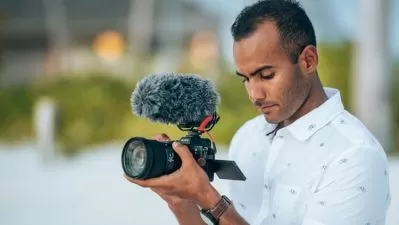About PhotographyLearn More
With a photography course on Udemy, you can learn to tell stories with the pictures you take. Photography classes can teach you how to use light, angles, and distance to achieve stunning photos. With the use of technology, you can also learn photo editing software, such as Photoshop and Lightroom, to enhance photos and create spectacular effects that will wow your audience.
Sort by:
Sorting
The newest
Most visited
Course time
Subtitle
Filtering
Courses
Subtitle

SkillShare


Rose Nene
Product Photography: How to Use Composition for Impactful Photos Skillshare Staff Pick 48:59
English subtitles
02/24/2023
Subtitle

SkillShare


Sophia Carey
A Guide to Photographing and Creatively Directing a Fashion Lookbook 45:30
English subtitles
02/14/2023
Subtitle

SkillShare


Rob Davidson
Photograph Your Own Artwork: For Your Website, Social Media, Skillshare or Print 1:04:45
English subtitles
01/18/2023

Udemy


YouAccel Training
Adobe Lightroom Classic CC: Print, Slideshow & Web Module 2:37:52
11/27/2022

Udemy


Charlie Borland
Using Wireless Speedlights in Adventure & Nature Photography 6:25:53
11/26/2022
Subtitle

Udemy


Lambros Lazopoulos
DJI Aerial Cinematography: A Beginner's Guide 46:37
English subtitles
11/16/2022
Subtitle

Udemy


Mark Timberlake
Photography - Classic Portrait Photography 1:56:13
English subtitles
11/15/2022
Books
Frequently asked questions about Photography
Photography is the process of recording light to create an image. It involves using a camera — either digital or film — to accurately capture portraits of people, landscapes, or anything else you can think of. The process of capturing light works by using a lens to project light rays onto a single point. This can be either a roll of film or a digital camera sensor, and when lined up in focus, it preserves the image clearly. Taking a photo is easy these days —all you usually need to do is press the shutter release button, and the camera will do the rest of the work. As a photographer, you’ll need to think about how to compose your image, use lighting to your advantage, use the correct lens for the situation, and tweak the settings on your camera to create stunning photos. These are all things you can learn in Udemy courses.
The three most important camera settings any photographer needs to think about are aperture, ISO, and shutter speed. Aperture controls the size of the opening of the lens that allows light through. You measure it using an f-stop value. A lower f-stop value means the lens opening increases, resulting in a brighter picture. A higher f-stop value, therefore, equals a darker photo. ISO signifies how sensitive your camera is to light overall. A higher ISO means your camera will work better in low light, but you’ll also have more graininess on the image. The shutter speed is the length of time you leave the sensor open to receive light. The higher the shutter speed, the less time light has to reach the sensor. This means that high shutter speeds are great for moving objects with a lot of light, while low shutter speeds are good for nighttime photos when there’s not much light around.
Photography can be easy to learn, especially if you take a course from Udemy. Our instructors can help you tackle the basics so you can get more comfortable behind the lens. In addition to learning about shutter speed, ISO, and aperture values, you can also learn about using different lenses for different photo opportunities. Anyone can use a camera in automatic mode, but our courses show you how to become more comfortable switching over to manual. While the technical issues of handling a camera are important, you also need to know how to set up and frame a photograph. Understanding how to work with natural light is also crucial, especially if you want to capture moody and natural-looking shots. Learning photography will take some experimenting, but that’s all part of the fun.
There are a few different kinds of photography you can focus on in your studies. Perhaps the two most prominent categories are digital and film. You may be more familiar with a digital camera, which uses a memory card to store photos. Film cameras, on the other hand, require you to develop film to see the images you captured. Once you decide on the type of camera you want to use, you can then specialize in a niche. Portrait photography involves taking pictures of people and may include taking headshots or full body shots in an attempt to highlight the subject’s personality. Sports photography is when you snap shots of players on the field, while still life photography is when you capture an inanimate object. You may even be interested in fashion photography, which involves taking pictures of models in glamorous settings.
The rule of thirds is a way to organize the composition of your photo. It involves strategically centering objects over an imaginary grid of nine squares. Some viewfinders come with this grid overlay to make placing the subject in your shot easier. If yours doesn’t, just imagine there’s an invisible grid of nine squares over your image. Your goal is to set the point of interest in your photo at the intersection of two of those lines. This balances out the image and draws the eye toward the subject. It can be tempting to just put the subject in the middle of the shot, but that’s actually counterintuitive to the way we view images. The rule of thirds follows the belief that most people’s eyes drift to these corners, so you might as well center your subject there to make them a focal point.
Photographers may work independently as freelancers or as salaried employees in a variety of settings. Photojournalists document newsworthy events, people, and places for a variety of outlets. Fine art photographers sell their work to clients such as architects and galleries or for use in public spaces like libraries and government buildings. Commercial photographers create images used in advertisements, catalogs, magazines, or other media with subjects like models, landscapes, and merchandise. Industrial photographers generally work onsite to create images of machinery and equipment and the people who use them. Finally, studio or portrait photographers take photographs of individuals or groups in a studio space or on location at events such as weddings, religious functions, or at schools. In addition to taking photos, studio and portrait photographers are also small business owners responsible for advertising, bookkeeping, and the mounting and framing of their work.
Learning photography can lead to a rewarding and lifelong hobby, or it could be the basis of a lucrative career. Creating an image that is beautiful and compelling or communicates an important idea or concept can be one of the most satisfying artistic endeavors. There’s a reason people say a picture is worth a thousand words. Photography requires a creative and imaginative personality, a desire to convey information or emotion meaningfully, and strict attention to composition and detail. Patience is necessary when gathering all the elements of a great photograph, whether it be waiting for the right light or for aligning your subject matter with other visual elements in just the right way to make a memorable and engaging image. Above all, it’s important to have a passion for communicating thoughts, feelings, or critical details precisely and clearly and a desire to share your artistic vision with the world around you.


















